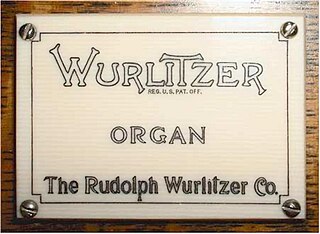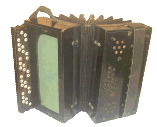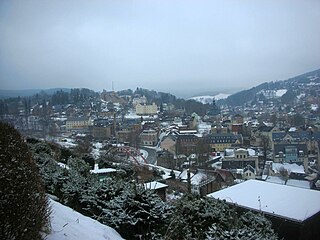
Castagnari is an Italian maker of accordions and melodeons, based in Recanati.

Castagnari is an Italian maker of accordions and melodeons, based in Recanati.
Castagnari has been producing accordions since 1914. The company was founded by a man named Giacomo Castagnari who had been an apprentice of the famous accordion maker Philip Guzzini. Castagnari opened up his own workshop and eventually handed the business down to his sons. As of 2013, the company has been passed down through three generations.
The Castagnari company is unusual in continuing traditional methods of producing accordions, such as drying the wood in a way that helps enhance the acoustics of the instrument. They have used the same techniques for over a century, and may make an instrument from a single block of wood. Castagnari accordions are known for their distinctive sound. [1] [2]

Accordions are a family of box-shaped musical instruments of the bellows-driven free reed aerophone type. The essential characteristic of the accordion is to combine in one instrument a melody section, also called the diskant, usually on the right-hand keyboard, with an accompaniment or Basso continuo functionality on the left-hand. The musician normally plays the melody on buttons or keys on the right-hand side, and the accompaniment on bass or pre-set chord buttons on the left-hand side. A person who plays the accordion is called an accordionist.

A concertina is a free-reed musical instrument, like the various accordions and the harmonica. It consists of expanding and contracting bellows, with buttons usually on both ends, unlike accordion buttons, which are on the front.
Celluloids are a class of materials produced by mixing nitrocellulose and camphor, often with added dyes and other agents. Once much more common for its use as photographic film before the advent of safer methods, celluloid's common present-day uses are for manufacturing table tennis balls, musical instruments, combs, office equipment, fountain pen bodies, and guitar picks.

An aerophone is a musical instrument that produces sound primarily by causing a body of air to vibrate, without the use of strings or membranes, and without the vibration of the instrument itself adding considerably to the sound.

The Avedis Zildjian Company, simply known as Zildjian, is an American musical instrument manufacturer specializing in cymbals and other percussion instruments. Founded by the ethnic Armenian Zildjian family in the 17th-century Ottoman Empire, the company relocated to the United States in the 20th century. Today, it is the largest cymbal and drumstick maker in the world.

C.F. Martin & Company is an American guitar manufacturer established in 1833 by Christian Frederick Martin. It is highly respected for its acoustic guitars and is a leading manufacturer of flat top guitars and ukuleles. The company has also made mandolins and tiples, as well as several models of electric guitars and electric basses, although none of these other instruments are still in production.

The bandoneon or bandonion is a type of concertina particularly popular in Argentina and Uruguay. It is a typical instrument in most tango ensembles. As with other members of the concertina family, it is held between the hands, and played by pulling and pushing air through bellows, routing it through sets of tuned metal reeds by pressing the instrument's buttons. Unlike most accordions, bandoneons always employ the same sets of reeds to produce their sound, and do not usually have the register switches common on accordions. Nevertheless, the bandoneon can be played very expressively, using various bellows pressures and other techniques. The left and right hand have different timbres due to the wooden box on the left side which gives the left hand a nasal and muted timbre, in contrast with the right hand which is usually bright and sharp.
In music, a bow is a tensioned stick which has hair coated in rosin affixed to it. It is moved across some part of a musical instrument to cause vibration, which the instrument emits as sound. The vast majority of bows are used with string instruments, such as the violin, viola, cello, and bass, although some bows are used with musical saws and other bowed idiophones.

A free reed aerophone is a musical instrument that produces sound as air flows past a vibrating reed in a frame. Air pressure is typically generated by breath or with a bellows. In the Hornbostel–Sachs system, it is number: 412.13. Free reed instruments are contrasted with non-free or enclosed reed instruments, where the timbre is fully or partially dependent on the shape of the instrument body, Hornbostel–Sachs number: 42.

The Rudolph Wurlitzer Company, usually referred to as simply Wurlitzer, is an American company started in Cincinnati in 1853 by German immigrant (Franz) Rudolph Wurlitzer. The company initially imported stringed, woodwind and brass instruments from Germany for resale in the United States. Wurlitzer enjoyed initial success, largely due to defense contracts to provide musical instruments to the U.S. military. In 1880, the company began manufacturing pianos and eventually relocated to North Tonawanda, New York. It quickly expanded to make band organs, orchestrions, player pianos and pipe or theatre organs popular in theatres during the days of silent movies.

A button accordion is a type of accordion on which the melody-side keyboard consists of a series of buttons. This differs from the piano accordion, which has piano-style keys. Erich von Hornbostel and Curt Sachs categorize it as a free reed aerophone in their classification of instruments, published in 1914. The sound from the instrument is produced by the vibration of air in reeds. Button accordions of various types are particularly common in European countries and countries where European people settled. The button accordion is often confused with the concertina; the button accordion's buttons are on the front of the instrument, where as the concertina's are on the sides and pushed in parallel with the bellows.

The Flutina is an early precursor to the diatonic button accordion, having one or two rows of treble buttons, which are configured to have the tonic of the scale, on the "draw" of the bellows. There is usually no bass keyboard: the left hand operates an air valve. A rocker switch, called a "bascule d'harmonie" is in the front of the keyboard. When this switch is thumb activated, it would open up a pallet (a pad that covers a tone hole, at the other end of the key button, for a simple Tonic/Dominant drone: Tonic on the draw and Dominant on the press, e.g. Tonic notes C/g, and Dominant G/d, without any major or minor thirds.

A Schrammel accordion is an accordion with a melody keyboard in the chromatic B-Griff system and a twelve-button diatonic bass keyboard. It is named for a traditional combination of two violins, accordion or clarinet, and contraguitar known as a Schrammelquartet – a group that played Schrammelmusik in the Vienna chamber music tradition.

A resonator guitar or resophonic guitar is an acoustic guitar that produces sound by conducting string vibrations through the bridge to one or more spun metal cones (resonators), instead of to the guitar's sounding board (top). Resonator guitars were originally designed to be louder than regular acoustic guitars, which were overwhelmed by horns and percussion instruments in dance orchestras. They became prized for their distinctive tone, and found life with bluegrass music and the blues well after electric amplification solved the problem of inadequate volume.

Klingenthal is a town in the Vogtland region, in Saxony, south-eastern Germany.
Valco was a US manufacturer of guitar amplifiers from the 1940s through 1968.

A Cajun accordion, also known as a squeezebox, is single-row diatonic button accordion used for playing Cajun and Creole music.

Gibson, Inc. is an American manufacturer of guitars, other musical instruments, and professional audio equipment from Kalamazoo, Michigan, and now based in Nashville, Tennessee.

The company Herbert Wurlitzer Manufaktur für Holzblasinstrumente GmbH is a German clarinet manufacturer based in Neustadt an der Aisch, Bavaria with a second production site in Markneukirchen, Saxony. It was founded in 1959 by Herbert Wurlitzer. His father Fritz Wurlitzer operated since the 1930s in Erlbach, now a district of Markneukirchen, a manufactory for the production of clarinets. The company W. Wurlitzer makes clarinets with German System and with the "Reform Boehm system", developed by Fritz Wurlitzer in the late 1940s, an instrument with Boehm fingering system and the sound of an Oehler Clarinet.

Seggelke Klarinetten, is a German clarinet manufacturer based in Bamberg in the Bavarian Upper Franconia. The company manufactures clarinets of a variety of fingering systems. A specialty of the company is the reproduction of historical clarinets.